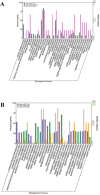Bioinformatics facilitating the use of microarrays to delineate potential miRNA biomarkers in aristolochic acid nephropathy
- PMID: 27418141
- PMCID: PMC5239550
- DOI: 10.18632/oncotarget.10586
Bioinformatics facilitating the use of microarrays to delineate potential miRNA biomarkers in aristolochic acid nephropathy
Abstract
Aristolochic acid nephropathy (AAN) is a rapidly progressive acute or chronic tubulointerstitial nephritis (TIN). The present study attempted to explore the molecular mechanisms underlying the miRNA-directed development of AAN. Our differentially expressed analysis identified 11 DE-miRNAs and retrieved the target genes of these DE-miRNAs; then, network analysis and functional analysis further identified 6 DE-miRNAs (has-miR-192, has-miR-194, has-miR-542-3p, has-miR-450a, has-miR-584, has-miR-33a) as phenotypic biomarkers of AAN. Surprisingly, of has-miR-192 has been reported to be associated with the pathogenesis of AAN, and has-miR-194, has-miR-542-3p and has-miR-450a was first-time identified to link to the development of AAN. In addition, the expressional changes of has-miR-584 and has-miR-33a may be associated with the development of AAN as well, which must be further confirmed by the associated experiments. Taken together, our work reveals for the first time the regulatory mechanisms of miRNAs in the development of AAN and this will contribute to miRNA-based diagnosis and treatment of AAN.
Keywords: aristolochic acid nephropathy; biomarkers; functional analysis; microRNAs; network biology.
Conflict of interest statement
The authors declare no conflicts of interest.
Figures




References
-
- Vanherweghem JL, Depierreux M, Tielemans C, Abramowicz D, Dratwa M, Jadoul M, Richard C, Vandervelde D, Verbeelen D, Vanhaelen-Fastre R, et al. Rapidly progressive interstitial renal fibrosis in young women: association with slimming regimen including Chinese herbs. Lancet. 1993;341:387–391. - PubMed
-
- Depierreux M, Van Damme B, Vanden Houte K, Vanherweghem JL. Pathologic aspects of a newly described nephropathy related to the prolonged use of Chinese herbs. American journal of kidney diseases. 1994;24:172–180. - PubMed
-
- Schmeiser HH, Stiborova M, Arlt VM. Chemical and molecular basis of the carcinogenicity of Aristolochia plants. Current opinion in drug discovery & development. 2009;12:141–148. - PubMed
-
- Chen YY, Chung JG, Wu HC, Bau DT, Wu KY, Kao ST, Hsiang CY, Ho TY, Chiang SY. Aristolochic acid suppresses DNA repair and triggers oxidative DNA damage in human kidney proximal tubular cells. Oncology reports. 2010;24:141–153. - PubMed
-
- Baudoux TE, Pozdzik AA, Arlt VM, De Prez EG, Antoine MH, Quellard N, Goujon JM, Nortier JL. Probenecid prevents acute tubular necrosis in a mouse model of aristolochic acid nephropathy. Kidney Int. 2012;82:1105–1113. - PubMed
MeSH terms
Substances
LinkOut - more resources
Full Text Sources
Other Literature Sources

